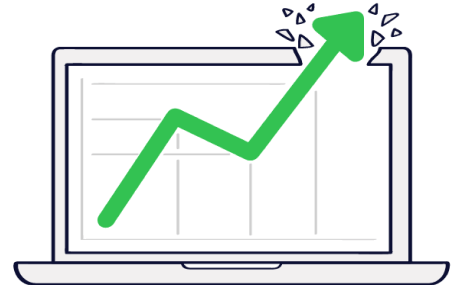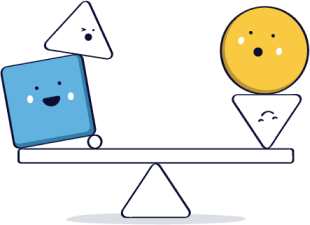Leverage the power of automation in your sales process
Learn how to set up a custom automated sales pipeline to streamline your sales process and ensure you and your team know exactly what to do at every stage.

Creating a structured sales process is one of the most effective ways to boost your sales teams’ efficiency and results.
With a formal sales process in place, your sales team has a framework to follow, and it’s much easier to stay on the same page, track results, and onboard new team members.
Even if your sales team is already driving good results, establishing a selling process or improving your existing one can take your business to the next level of growth.
In this guide to sales processes, we’ll cover what a sales process is and discuss the most common stages of the sales process, how to develop and improve your process, how to overcome common challenges, and more.
Just keep reading to get started with creating a winning sales process.

Learn how to set up a custom automated sales pipeline to streamline your sales process and ensure you and your team know exactly what to do at every stage.

A sales process is a set of repeatable steps that your sales team takes to convert prospects into customers. Building a sales process template is absolutely necessary for your company’s success, and is perhaps the most important thing you can do as a sales manager to impact your team’s ability to sell.
As mentioned above, the sales process refers to a defined series of repeatable steps that your sales team follows to turn leads into customers. You can think of it as the structured path that outlines the specific actions needed to close deals and cultivate client relationships throughout the sales cycle.
On the other hand, a sales methodology acts as the foundational framework that guides how these steps are carried out. It encompasses the philosophies and strategies that shape your sales team’s approach at each stage of the selling process.
By aligning effective sales cycle stages with a suitable methodology, you can greatly improve your chances of closing deals and achieving sustainable growth.
Now that you know what a sales process is and how it differs from a sales methodology, let’s take a look at why implementing a structured selling process is crucial for your business.
A structured sales process is the backbone of any successful sales operation, providing a clear roadmap for sales teams to follow. This structured approach isn’t just a guideline. It’s a strategic framework designed to optimize efficiency, consistency, and results. Here’s why having a structured sales life cycle is so important:
A well-defined sales process keeps your entire sales team on the same page. Consistency in approach and messaging instills confidence in your team, as they know what to expect with each potential deal.
By breaking down the sales journey into well-defined stages, a structured process empowers sales professionals to navigate the process more efficiently. Each stage has its purpose and a set of actions, reducing ambiguity and the likelihood of missed opportunities.
A structured sales process allows for accurate tracking and analysis of each stage’s performance. This data-driven approach helps you identify bottlenecks, refine strategies, and make informed decisions that create continuous improvement.
Having a formalized selling process ensures that your team focuses its efforts on the activities that generate the most revenue. Without a process in place, deals are simply won or lost, and it’s hard to know which specific actions are working or failing.
A repeatable sales cycle gives sales teams much more consistency in winning deals. Having a more accurate sense of your win rate allows you to dependably forecast how many sales you’ll close from a given number of leads, and helps sales managers set realistic quotas.
With a well-honed sales process in place, your sales team will be more effective at filtering out low-potential leads and identifying prospects who are most likely to purchase your product and become longtime customers.
Generating higher-quality leads shortens your sales cycle, reduces the effort wasted on opportunities that are unlikely to close, and increases lifetime customer value by focusing your sales efforts on the best prospects.
If your sales team speaks a language only they can understand, collaboration between departments can be difficult. Using the common steps and language of a standardized sales process simplifies company communication, reduces interdepartmental confusion, and enables your customer service, account management, fulfillment, and marketing teams to offer the right assistance at the right time.
When a sales rep rushes a prospect into a sales stage they’re not anticipating, it can create distrust, which can kill the sale and damage the relationship with the buyer. A standardized sales process ensures that sellers don’t advance the sale until the buyer is ready to move forward.
By tailoring the sales process to reflect how a company’s target customers move through the buying process, and making sure each step is designed to generate trust and offer value, sales teams can lay the foundation for a positive customer experience before the deal is even closed.
A clearly defined process simplifies the training and onboarding of new sales team members. It provides a framework that enables new hires to quickly understand your sales approach and start contributing to your organization’s success.
Want to learn more about what a sales process is and why it’s important? Read this first. If you already have a sales process built, you can skip ahead to the next guide in our series, How to Implement a Sales Process.

The sales process is comprised of several stages, typically ranging from three to seven, depending on the complexity of the sale. Each stage involves specific tasks that advance the sale toward completion. The essential stages of a sales process include:
These stages can vary by industry but generally form the backbone of an effective sales life cycle. Below, we elaborate on each stage of the sales process.
Also known as lead generation, prospecting involves identifying potential buyers to add to the top of your sales funnel. These potential buyers can be people who have expressed interest in the product or service that you’re selling or who might reasonably have interest based on their demographics, industry, or other factors.
This step of the sales cycle is often done through online research, buying lead lists, referral networking, or inbound marketing methods. It is best practice to target your ideal buyer persona throughout prospecting efforts. This increases the odds that the leads you generate will eventually become closed deals.
Your ideal customer consists of as many target demographics as possible, from job title and income level to age and hobbies. From here, you can begin expanding on the demographics you’re appealing to and start developing your target market.
A sales prospecting tool such as Nutshell ProspectorIQ lets you find your ideal customer from a database of 200 million people and companies. Since you can add them from within your CRM platform, you save time on manual lead data entry and add your new leads to your established sales pipelines to start selling ASAP.
Define your ideal customer and ProspectorIQ does the heavy lifting, so you can add new contacts to your CRM and start making more sales!

The qualifying stage marks the first time your reps make direct contact with a lead. Through an initial phone call or email, the rep’s goal is to gather information on the lead and determine if they are a good fit for your product or service.
The most well-known qualifying framework is BANT—budget, authority, need, and timeline. In other words, if your sales team can determine that a lead actually wants what you’re selling and has the money and decision-making power to buy from you in the near future, then they’re qualified to move on to the next stage.
The most important step to take when learning how to create the best sales process is correctly identifying your target market. First, define the external criteria that will help you identify companies that are likely experiencing the pain points your product or service solves. Then, identify the people within those organizations who are personally suffering from those pain points and who have the authority to make buying decisions.
Whitney Sales Founder of The Sales Method
Selling in today’s saturated market depends more than ever on developing personal relationships, or at the very least a decent rapport, with your leads. Even if your brand offers unique products or services, the best way to stand out among your competitors is by making an emotional appeal to potential buyers.
People naturally react more strongly when emotionally invested in something, and when you pursue a personal connection with them, you’ll make them feel like more than a number. They’re not your customers or business partners — they’re your friends, and when they feel like your friends, they’ll be there to support you through anything.
Whether you’re doing an on-site demonstration for a potential client or using video conferencing to present a software solution, presenting is your sales team’s opportunity to lay out a compelling, personalized case for how your product or service will fulfill the prospect’s immediate needs.
Success in the presenting stage depends heavily on research and preparation. Before you make your presentation, you should have gathered as much information as possible about your prospect and their specific needs and concerns so that you can anticipate every follow-up question and have a good answer ready to go. If you can position yourself as a trusted advisor instead of someone who’s just trying to make a sale, you’re doing it right.
Related: 19 ways to nail your next sales presentation
There are plenty of reasons why a prospect would be hesitant to commit, even if they’re interested in your product—price, timing, and fear of change are some of the common ones. In the objections stage, a sales rep attempts to address all the outstanding concerns that a prospect still has after hearing your pitch.
No matter what a prospect’s objection may be, knocking it down generally involves two things: demonstrating the value of your solution and demonstrating the cost or risk of not buying.
Hate your current CRM? Still working off spreadsheets? Register for our “Intro to Nutshell” live demo and see why sales teams love us!
Closing is everything you need to do in the late stages of the sales process to get your prospect to sign a contract and become a customer. This could include delivering a proposal based on verbally agreed-upon terms, getting buy-in from all the decision-makers, and making final negotiations on the price. With every roadblock out of the way, you’re ready to ask for their signature and begin the hard work of retaining them as customers.
The final step in the sales process is to follow up and nurture your relationship with the customer. This is the sales process stage that you want to last the longest. Nurturing a customer means providing them with the proper post-sale support so that they’re excited to continue buying from you and finding opportunities to increase the value of the business relationship through upselling. Well-nurtured customers can also provide a significant source of referrals, making them a priceless lead source in themselves.
Pro tip: Each sales process stage should have a clear definition or goal: What observable activity or action tells you that a customer is in a particular stage of the buyer journey?
Our 16 Sales Process Templates for B2B Pipelines provide top examples of how companies just like yours structure their sales processes.

Sales teams incorporate these intermediate stages into their sales processes to put additional focus on important activities rather than milestones.
It’s the first major commitment you make with a prospective buyer. After a lead is qualified, a rep’s #1 priority should be locking down a time for their presentation.
Gathering information on a prospect should be part of every stage of your sales process, but it’s critically important before the presentation. Through conversations and online research, your goal should be to identify your buyer’s pain points and needs, as well as any other unique characteristics that you can use to create a tailor-made solution.
Focusing on your product is fine—but ultimately, you have to convince your prospect why they should do business with you. Are you trustworthy? Do you have specialized insight into your industry?
The “demonstrating value” stage means providing targeted content (including customer testimonials and competitive battle-sheets) as well as answering questions to position yourself as a trusted advisor.
Here’s where you take all the talking and put it into writing. Based on the solutions you discussed with your prospect, lay out exactly what your company will provide, at what price, and over what timeline.
The transaction isn’t a success until the customer gets what they’re paying for. Whether it’s the physical delivery of a product or the onboarding of a cloud software service, make sure you get off on the right foot with your newly closed buyer by executing this step flawlessly.
Once you’ve picked out your stages and tasks, it’s time to give your sales process a coherent structure. Here are four sales process formats you can use for inspiration.
Arranging your stages into vertical columns might be the most natural way to organize and visualize your sales process—which is why we decided to structure it this way in Nutshell. In a selling process map, the top of each column is labeled with a stage, and the individual steps are listed below it.
While the steps listed in each column reflect the sales activities that your team needs to complete, sales process maps can also include arrows linking each column to denote the stages of the buyer’s journey that the customer is moving through.

A checklist sales process is arranged chronologically from top to bottom, with steps listed underneath each sales stage. Once you check off each completed step in a given stage, you can move on to the next one. This format is best for simple sales processes that don’t have a lot of moving parts.

Pro tip: Leads in a sales process are either in an “open” stage, meaning they’re still being worked, or in a “closed” stage, meaning they’ve concluded—either won or lost.
While a checklist or column arrangement can work well for simple sales transactions, more complex sales tracking can’t always be managed with a step-by-step chronological process. If each customer decision can spur different “paths” for your sales rep to take, a flowchart might be a more appropriate method to visualize your selling process.
For example, what do your reps do when a lead doesn’t advance past a certain step? Is the lead abandoned forever, or is it directed to a “winback” path where you try to reconnect with the prospect at a later date to see if they still need help finding a solution? With a sales process flowchart, you can add “Plan B” steps that can eliminate the dead ends that arise in a more straightforward sales process.

Ultimately, each sale represents an alignment of the buyer’s and seller’s interests. Incorporating the steps of the buyer’s journey into your sales process reminds your sales reps to consider what the buyer needs at each step.
After you’ve decided on your own selling process stages, put yourself in your customer’s shoes and add the key commitments and decisions that the buyer has to make along the way. If both sides of your buyer-aligned sales process closely mirror each other, you’re doing it right.

So, how do you know which stages to include in your sales process, and how can you ensure your process is driving optimal results over time?
There’s a lot to consider when it comes to sales processes, but it doesn’t have to be overwhelming. Remember—your sales process doesn’t have to be perfect right away. In fact, it should evolve and improve over time. Start with the basics and make updates as you learn more about what drives the best results with your audience.
Check out our top tips for creating and improving your sales process below.
Your sales process steps should reflect and support your customers’ buying process and help your reps understand what kind of attention each prospect needs at any given moment.
“For complex B2B sales environments that involve a lengthy buying process and multiple customer stakeholders, the best way of defining your pipeline stages is to align them with the key phases in your customer’s typical decision-making process,” says Inflexion-Point Strategy Partners founder Bob Apollo.
In a typical complex sale, these key decision phases can include the following.

Even if you’ve never formalized your sales process before, the raw materials are in place. Your reps likely have a general outline of sales activities that they follow for each sale, including commitments that they have to secure along the way from their prospects.
The first step in building a sales process template is gaining a full understanding of what your sales team is currently doing to turn leads into customers.
“Too often, sales managers build a sales process that has no relevance or familiarity with what the team is already doing,” says former Nutshell CEO Joe Malcoun. “Not only do you want your reps to recognize what you are asking of them, but you need them bought in from the beginning.”
Malcoun suggests sitting down with each member of your sales team to learn the actual steps that they’re taking to move a lead through your funnel. “Find out how they visualize the process—even in the absence of one—and build yours so that it’s familiar to your team, using their language as much as possible.”
To help with this process, take a handful of your recent leads and go through the following questions with your reps. Their answers will help you understand the specific activities that your team is currently performing during the course of a sale.
If you don’t have answers to all of the above questions at first, don’t worry. When learning how to create a sales process, you’ll define exactly what should happen at each point of the sale so that all of your reps do some sales planning and follow the same sales plan.
Each sales process stage should have clearly defined goals and objectives, including specific criteria required to move a lead from one stage to the next.
“If you accept the principle that your stages should be based on key phases in the customer’s buying decision process, then the obvious way of establishing the criteria required to advance the opportunity from one stage to the next is through verifiable evidence of the customer’s willingness to take the next step,” advises Bob Apollo.
“For example, between the ‘investigating’ and ‘defining’ stages of the customer decision process, the milestone might be that the customer acknowledges there is a compelling business reason to act. Moving from the ‘defining’ stage to the ‘selecting’ stage could mean that the decision criteria and process are agreed and the shortlisted options are identified.”
“The process should always focus on the customer, and customers can be very different across industries, whether you’re a B2C healthcare organization or a B2B infrastructure company,” says Jacco vanderKooij, founder of Winning by Design and author of Blueprints For A SaaS Sales Organization. “All sales processes contain similar building blocks, but the stages might be in a different order, the key activities could be executed differently, or you might need a few unique stages—a compliance stage in the financial industry, for example.”
“Your industry also affects how your leads are sourced,” adds Joe Malcoun. “At Nutshell we receive thousands of leads online via our website. On the other hand, some of our customers meet three people a year at conferences and that will be all the business they need to be successful.”
In sales, there are constant innovations designed to make your job easier. New technologies allow you to automate tasks like sending form emails and scheduling appointments, allowing you to focus your workforce where it needs to be.
Perhaps the best tech for keeping up with your selling process is customer relationship management (CRM) software like Nutshell. A CRM enables you to outline your sales process and track leads as they move through it. With Nutshell, you can collaborate with your team, automate elements of your process, assign leads to reps, and much more.
With Nutshell IQ, you can fill your sales pipeline with qualified leads by discovering and adding more high-value opportunities to your CRM, all from one platform. The comprehensive lead generation suite includes:
Learn more about Nutshell IQ and contact our team to learn more about how you can enrich your CRM data with qualified leads and opportunities.
Take our guided tour to explore Nutshell’s incredible features!

In any job, an expert completes better work faster than an amateur. But you can turn any amateur into an expert with the proper training. Training your team in the latest sales techniques is an investment in your business as a whole.
When you equip your people with knowledge of various parts of your sales process, you enable them to become experts in those areas. For example, an employee who’s been well-trained in qualifying leads can do so more effectively by streamlining the process, learning what methods work best, and implementing them.
How can you understand your niche in the industry if you don’t know your competition? Understanding your industry’s competitive landscape can help you develop new ways to set yourself apart from your competitors, increasing your chances of drawing in new customers.
Start your research by discovering brands offering similar products and services as you. Try to find ones that share your targeted audiences and locations for the best results. Then, analyze what makes them effective. Ask yourself:
Answering these questions will show you where your competition thrives and how you can use similar strategies (or avoid unsavory ones) in your own sales tactics. Identifying areas of differentiation and advantage allows you to better display and utilize what makes you unique.
What’s the key to maintaining an effective sales process? Documentation!
A roadmap lets you display your entire process so you and other people in your department can consistently recreate the perfect sales plan every time. It helps you manage everything from starting goals to presentation and publication, letting you identify places where you may need more research or add contact information for support people who can help along the way.
How will you know when all your hard work starts paying off? Tracking your data, traffic, and other areas of performance is the best way to measure how well your efforts are paying off.
This is another area where automated technology software can change the game. Much of the available software has data collection capabilities to monitor your metrics and provide you with real-time access any time you need it.
Finally, with every improvement you make comes the need for evaluation and improvement. The best way to see how well your sales strategies are working is to ask the people you’re serving — your customers.
Customer surveys and feedback invitations give your buyers space to express the parts of the buying experience that worked well for them and which parts have room for improvement. When you combine this information with your sales data, you should clearly see where you’re thriving and where you need to focus your attention.
Common areas many brands find themselves adjusting are within their sales pitch, product or service specifications, and the buying process. These changes can improve customer satisfaction and offer a more enjoyable experience to new leads.

Attend a live guided tour!

A sales objection is the reason a prospect will not buy or will hesitate to buy your service or product. Getting past these objections and walking leads through the pipeline is a central function of a sales rep’s job. Knowing and dealing with these concerns effectively is an important step in the sales process.
Make a list of typical objections and craft a specific reply for each. Bring your team together for brainstorming, examine proper forums, and look at your channels of outreach. Scan past call transcripts and emails to clarify your strategy. Craft scripts to overcome these objections head-on at the first point of the contact stage.
There will always be unexpected objections. The best approach to dealing with them is to listen carefully and take your time to respond. Don’t hesitate to request a moment to consider things so you can respond to the lead’s concerns with sensitivity. Begin by asking questions to better understand and base your response on their answers. You can also make notes and get back to them after you have had a chance to think more deeply about their issues.
Following an objection by a buyer, double-check that you’ve satisfied all their concerns. Don’t overestimate agreement through a mere head nod. Don’t hesitate to ask whether they’re okay with your solution or clarify it for them. Keep in mind that objections to sales are sometimes a process and not a quick fix. If the buyer is still hesitant, don’t push for a commitment. Likewise, don’t accept a lukewarm “yes” because the root objection may reappear later.
With every sale comes the possibility of an unexpected complication or challenge. Not every lead will convert, and not every potential buyer ultimately wants to invest in your products or services. Let’s talk about some of the challenges you’ll face when working through your sales process steps and some simple remedies you can employ.
From a lack of effective marketing to a lack of perceived relevance from customers, there are many reasons why your services may not be making the major splash you’d hoped for. Adjusting your advertising strategy is the first way to remedy this.
Competition is a natural part of running a business, but price wars can leave even the biggest contenders feeling run down by their lack of profit. Even when your competitors put up a fair fight, you have options for other sales tactics.
Many businesses are forced to work with limited lead generation and prospecting resources, despite how important these activities are for growing your pipeline. Your team may need to develop creative strategies to continue expanding your reach.
Invest in professional marketing services from WebFX and kick your company’s growth into high gear.

People’s attention spans grow shorter every day, making the challenge of keeping their attention long enough to convert them larger than ever.
Even as potential buyers get close to making a purchase, they can have doubts about their decision or questions that need to be answered. One of your sales team’s many jobs is ensuring they have all the information they require to make the best decision for them.
The longer a lead stays in the buyer’s funnel, the more likely they’ll talk to many of your sales team members and receive varying levels of service. This can lead to confusion and ultimately make a customer think investing in your brand is not worth the hassle.
To fully reap the benefits of your sales process, it’s crucial for your entire team to consistently follow the established selling process steps. Nutshell simplifies this by guiding you through implementing and automating your sales process within our CRM, making managing leads and optimizing your sales pipeline easier than ever.
Nutshell’s all-in-one affordable CRM solution provides you with features like sales automation, detailed reporting, and effective pipeline management, helping you streamline your sales cycle and enhance customer relationship management. If you’re ready to elevate your sales process and drive better results, sign up for a free trial today!
Try Nutshell free for 14 days or let us show you around before you dive in.

Join 30,000+ other sales and marketing professionals. Subscribe to our Sell to Win newsletter!
 Email & Calendar Sync
Email & Calendar Sync
Use our calculator to add up your total investment of CRM and Add-ons
VIEW ALL PRICING
 Product Info
Product Info Education & Guides
Education & Guides Company
Company